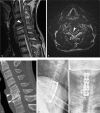Cervical disc herniation causing Brown-Sequard syndrome: Case report and review of literature (CARE-compliant)
- PMID: 30213001
- PMCID: PMC6156073
- DOI: 10.1097/MD.0000000000012377
Cervical disc herniation causing Brown-Sequard syndrome: Case report and review of literature (CARE-compliant)
Abstract
Rationale: Brown-Sequard syndrome (BSS) is manifested as ipsilateral motor deficit and contralateral sensory loss. BSS caused by herniated cervical disc is extremely rare and easily be misdiagnosed, and clinical features of this problem were not fully understood.
Patient concerns: A 57-year-old man presented with a 3-month history of weakness in his right arm, and he experienced progressive right hemiparesis at 2 days before admission, along with contralateral deficit in sensation of pain and temperature below T2.
Diagnoses: Magnetic Resonance Imaging (MRI) showed severe cord compression due to a large paracentral extradural C4-C5 cervical disc herniation (CDH).
Interventions: Subtotal cervical corpectomy, decompression, and fusion through anterior approach were performed. The patient recovered rapidly after surgery.
Outcomes: Complete recovery of sensory and motor functions was obtained at a 4-months follow-up after surgery.
Lessons: Our case, along with a review of the literature, highlights that careful medical history inquiries, detailed neurologic examinations, and cervical spinal MRI scans are essential for diagnosis of CDH caused BSS. Prompt surgical decompression according to individual condition is commonly warranted. Early diagnosis with prompt surgical decompression could lead to favorable recovery.
Conflict of interest statement
The authors have no conflicts of interest to disclose.
Figures

References
-
- Brown-Sequard C. De la transmission des impressions sensitives par la moelle epiniere. CR Soc Biol 1849;1:192–4.
-
- Abouhashem S, Ammar M, Barakat M, et al. Management of Brown-Sequard syndrome in cervical disc diseases. Turk Neurosurg 2013;23:470–5. - PubMed
-
- Stookey B. Compression of the spinal cord due to ventral extradural cervical chondromas: diagnosis and surgical treatment. Arch Neurol Psych 1928;20:275–91.
-
- Lee JK, Kim YS, Kim SH. Brown-Sequard syndrome produced by cervical disc herniation with complete neurologic recovery: report of three cases and review of the literature. Spinal Cord 2007;45:744–8. - PubMed
Publication types
MeSH terms
LinkOut - more resources
Full Text Sources
Other Literature Sources
Medical
Miscellaneous

